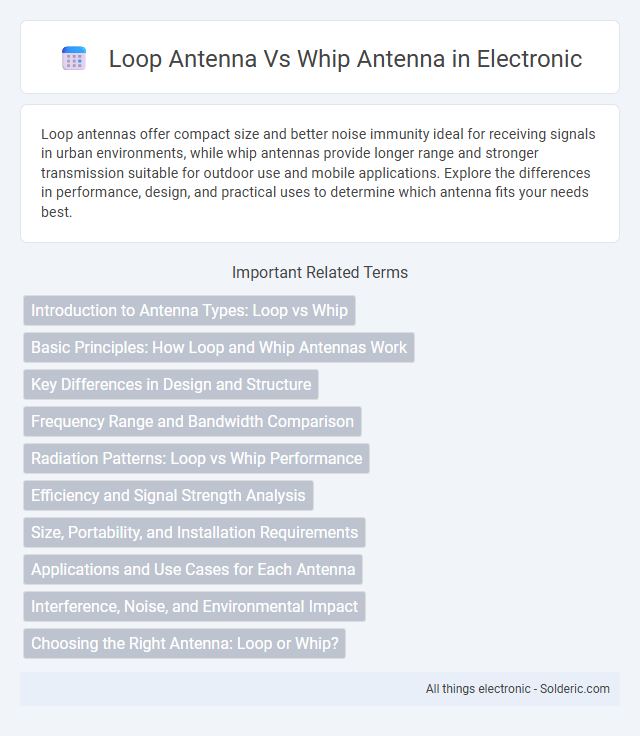Loop antennas offer compact size and better noise immunity ideal for receiving signals in urban environments, while whip antennas provide longer range and stronger transmission suitable for outdoor use and mobile applications. Explore the differences in performance, design, and practical uses to determine which antenna fits your needs best.
Comparison Table
| Feature | Loop Antenna | Whip Antenna |
|---|---|---|
| Design | Loop of conductor, typically circular or square | Straight, flexible rod or wire |
| Size | Compact, small footprint | Longer, length approximately quarter wavelength |
| Radiation Pattern | Bidirectional or omnidirectional depending on orientation | Omnidirectional in horizontal plane |
| Frequency Range | Effective for lower frequencies, LF to HF bands | Effective from VHF to UHF bands |
| Sensitivity | Better for magnetic field detection, less affected by nearby objects | Higher gain for vertically polarized signals |
| Polarization | Magnetic field (H-field) polarization | Electric field (E-field) vertical polarization |
| Typical Use | Direction finding, AM radio receiving, LF/HF monitoring | Mobile communication, handheld radios, broadcasting |
| Installation | Requires orientation for best performance | Omnidirectional, minimal setup |
Introduction to Antenna Types: Loop vs Whip
Loop antennas exhibit a compact, circular design ideal for receiving and transmitting low-frequency signals with high directionality and minimal noise interference. Whip antennas feature a straight, flexible element that excels in broad frequency ranges and omnidirectional radiation, commonly used in mobile communication. Your choice depends on the intended application: loop antennas suit precise direction finding and noise reduction, while whip antennas provide versatile coverage and ease of deployment.
Basic Principles: How Loop and Whip Antennas Work
Loop antennas operate by detecting magnetic fields generated by radio waves using a coil of wire shaped in a loop, making them sensitive to the magnetic component of electromagnetic signals. Whip antennas function as monopoles that transmit and receive radio waves by converting electrical signals into electromagnetic radiation through a vertical conductor, primarily responding to the electric field. Understanding how your loop or whip antenna works helps optimize signal reception and transmission based on the specific propagation characteristics each antenna type favors.
Key Differences in Design and Structure
Loop antennas feature a circular or rectangular coil of wire designed to receive magnetic fields, providing compact size and directional properties ideal for low-frequency applications. Whip antennas consist of a single, straight flexible rod usually made of metal, optimized for wideband performance and omnidirectional radiation patterns at higher frequencies. The structural distinction lies in the loop antenna's closed conductive path enhancing magnetic field coupling, whereas the whip antenna relies on the length of the rod for efficient electromagnetic wave propagation.
Frequency Range and Bandwidth Comparison
Loop antennas typically operate efficiently within low to medium frequency ranges, offering narrow to moderate bandwidth suited for specific signal reception. Whip antennas cover a wider frequency range, especially effective in VHF and UHF bands, providing broader bandwidth and better versatility for various communication needs. Your choice depends on whether frequency selectivity or wideband performance is more critical for your application.
Radiation Patterns: Loop vs Whip Performance
Loop antennas exhibit a doughnut-shaped radiation pattern with maximum signal strength perpendicular to the loop plane, ideal for direction finding and minimizing interference. Whip antennas radiate in an omnidirectional pattern, providing consistent signal coverage in all horizontal directions, making them suitable for mobile communication. Understanding your application's radiation pattern requirements ensures optimal antenna performance and signal reliability.
Efficiency and Signal Strength Analysis
Loop antennas generally offer higher efficiency in receiving weak magnetic signals due to their smaller size and reduced noise susceptibility, making them ideal for low-frequency applications. Whip antennas provide stronger signal strength for transmission and reception at higher frequencies because of their longer radiating element and better impedance matching. Your choice depends on whether signal integrity in noisy environments or broader frequency coverage with robust signal strength is more critical for your application.
Size, Portability, and Installation Requirements
Loop antennas are generally more compact and lightweight, making them highly portable and easier to install in confined spaces. Whip antennas tend to be longer and less convenient for portable use but offer straightforward installation with simple mounting requirements. Your choice depends on space availability and ease of setup, with loop antennas favoring minimal size and portability, whereas whip antennas prioritize ease of installation.
Applications and Use Cases for Each Antenna
Loop antennas excel in applications requiring compact size and directional signal reception, such as in direction-finding equipment, AM radios, and magnetic field sensing for industrial or scientific use. Whip antennas are widely used in mobile communications, including handheld radios, vehicle-mounted transceivers, and marine or aviation communication systems, where omnidirectional coverage and easy installation are crucial. Each antenna type suits specific environments: loop antennas thrive in urban areas with high electromagnetic interference, while whip antennas perform well in open spaces with line-of-sight communication needs.
Interference, Noise, and Environmental Impact
Loop antennas exhibit superior noise rejection capabilities compared to whip antennas due to their ability to nullify electromagnetic interference through directional properties, making them ideal for urban environments with high signal pollution. Whip antennas are more susceptible to man-made noise and atmospheric interference because of their omnidirectional reception pattern, which captures a broader spectrum of unwanted signals. Environmental factors such as nearby metallic structures and electrical equipment further degrade whip antenna performance, whereas loop antennas maintain stable operation by minimizing environmental impact on signal integrity.
Choosing the Right Antenna: Loop or Whip?
Choosing the right antenna depends on your specific application and environment. Loop antennas offer superior noise rejection and are ideal for receiving weak signals in urban or electrically noisy areas, while whip antennas provide better bandwidth and are more effective for general-purpose transmission and reception. Your choice should consider factors like signal strength, interference levels, and space constraints to optimize performance.
loop antenna vs whip antenna Infographic

 solderic.com
solderic.com